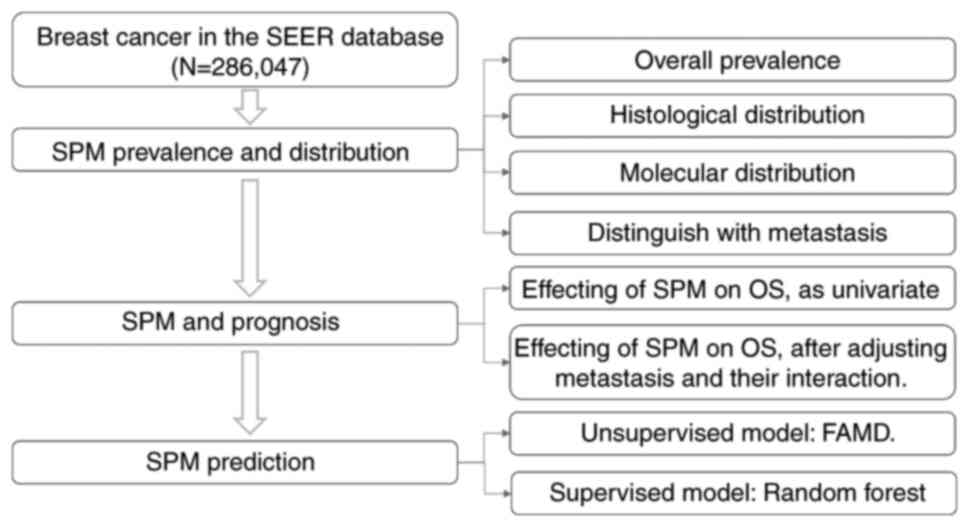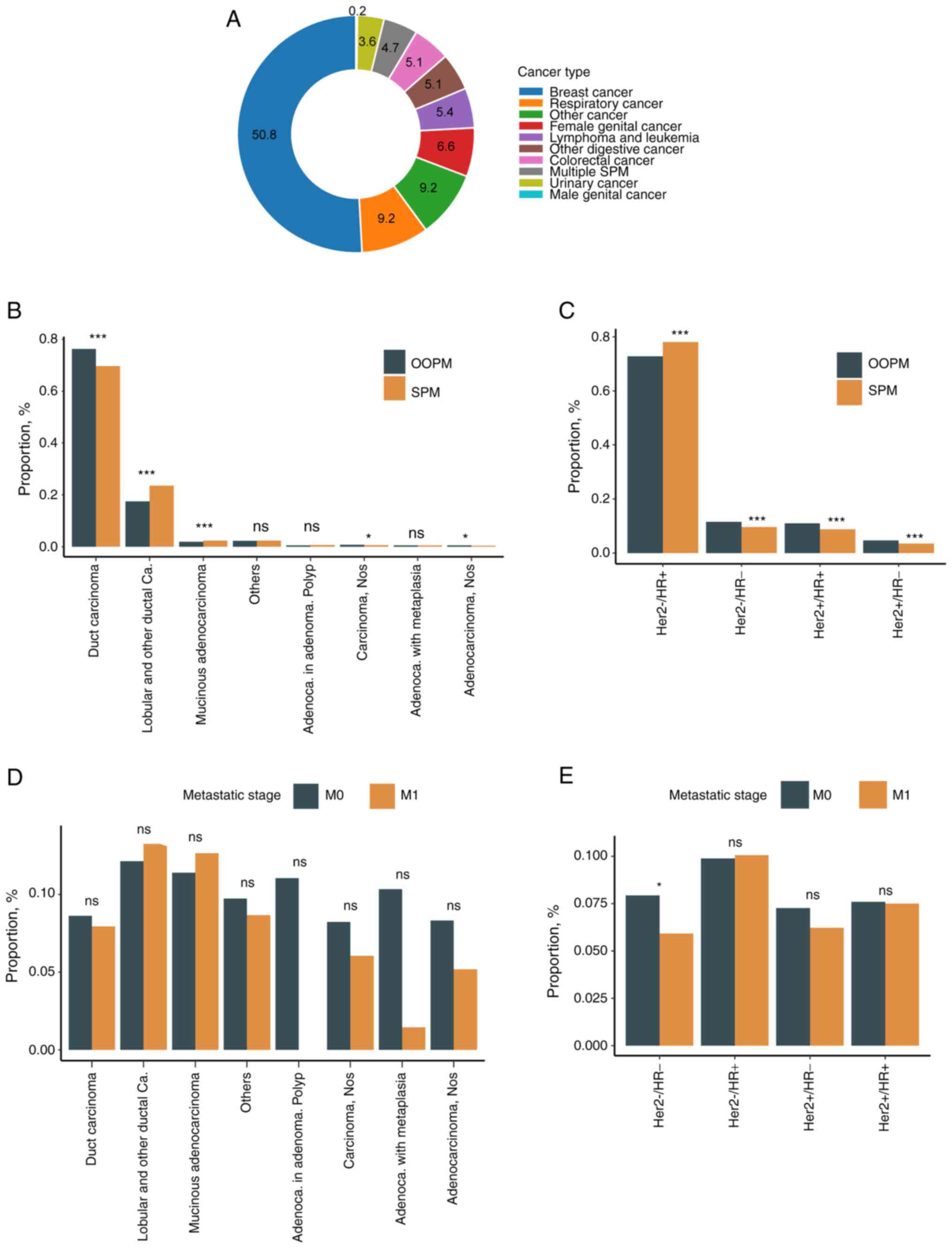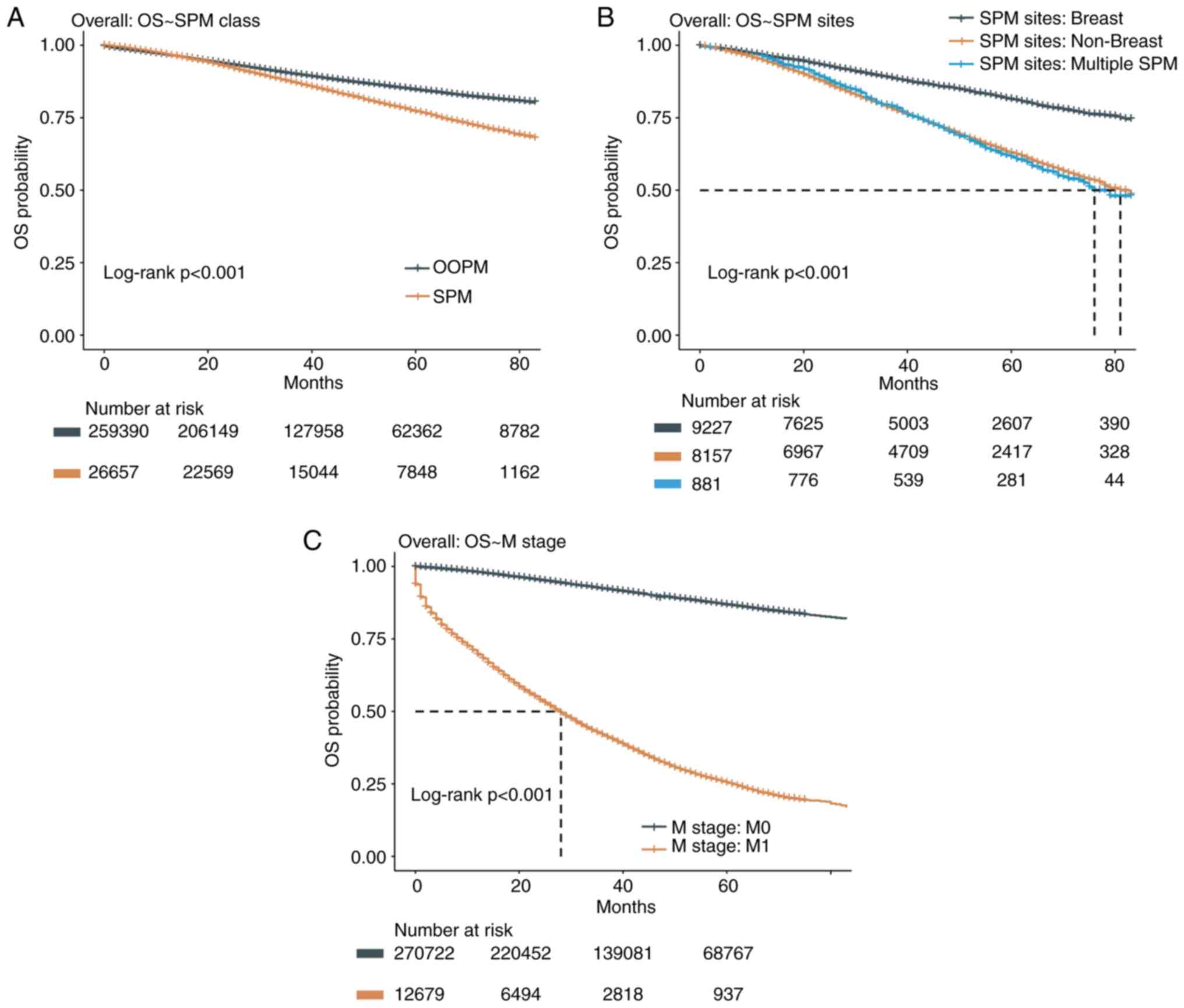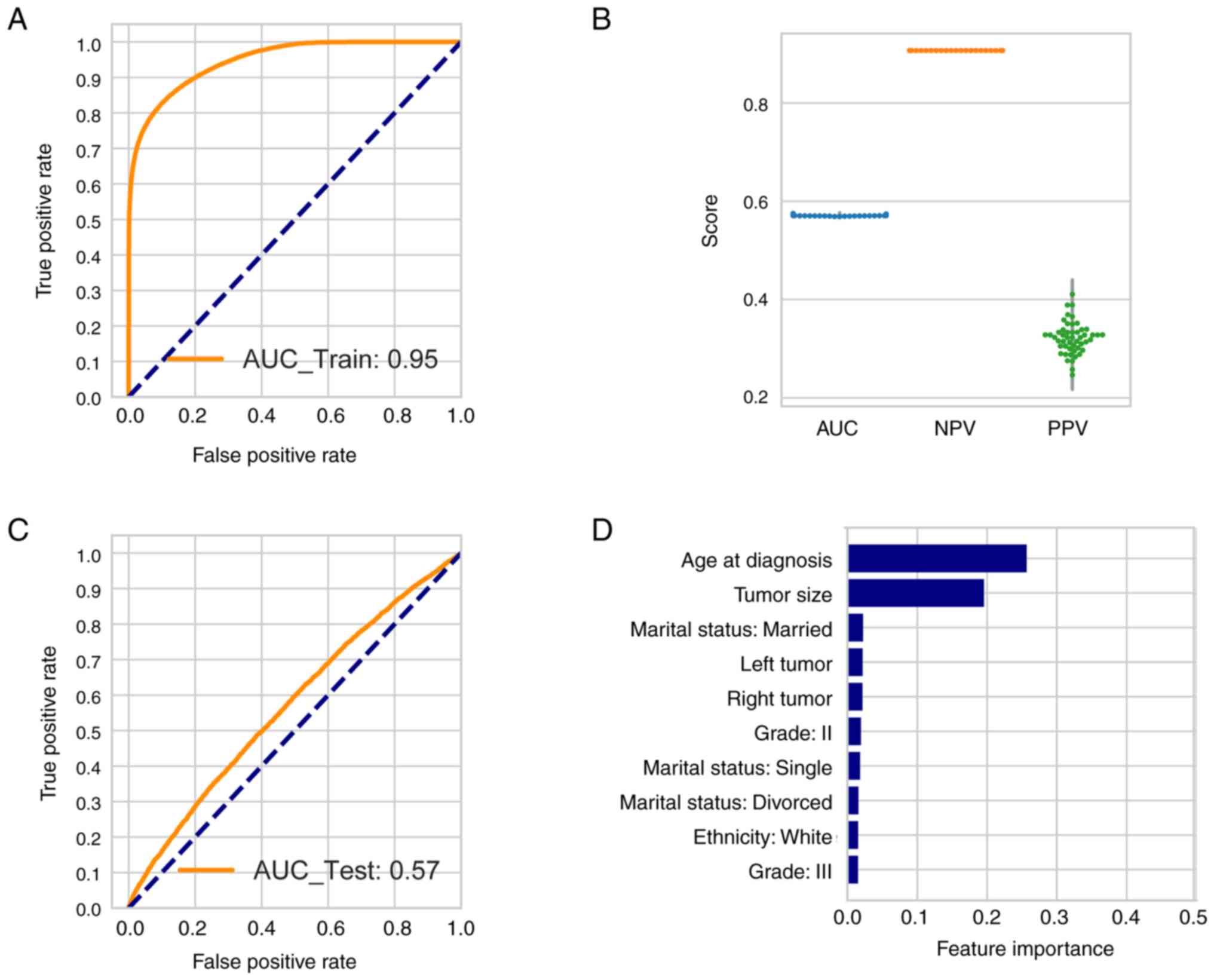|
1
|
Global Burden of Disease Cancer
Collaboration. Fitzmaurice C, Akinyemiju TF, Al Lami FH, Alam T,
Alizadeh-Navaei R, Allen C, Alsharif U, Alvis-Guzman N, Amini E, et
al: Global, regional, and national cancer incidence, mortality,
years of life lost, years lived with disability, and
disability-adjusted life-years for 29 cancer groups, 1990 to 2016:
A systematic analysis for the global burden of disease study. JAMA
Oncol. 4:1553–1568. 2018.PubMed/NCBI View Article : Google Scholar
|
|
2
|
Molina-Montes E, Requena M,
Sanchez-Cantalejo E, Fernandez MF, Arroyo-Morales M, Espin J,
Arrebola JP and Sánchez MJ: Risk of second cancers cancer after a
first primary breast cancer: A systematic review and meta-analysis.
Gynecol Oncol. 136:158–171. 2015.PubMed/NCBI View Article : Google Scholar
|
|
3
|
Song F, Qureshi AA, Giovannucci EL, Fuchs
CS, Chen WY, Stampfer MJ and Han J: Risk of a second primary cancer
after non-melanoma skin cancer in white men and women: A
prospective cohort study. PLoS Med. 10(e1001433)2013.PubMed/NCBI View Article : Google Scholar
|
|
4
|
Donin N, Filson C, Drakaki A, Tan HJ,
Castillo A, Kwan L, Litwin M and Chamie K: Risk of second primary
malignancies among cancer survivors in the United States, 1992
through 2008. Cancer. 122:3075–3086. 2016.PubMed/NCBI View Article : Google Scholar
|
|
5
|
Heard A, Roder D and Luke C: Multiple
primary cancers of separate organ sites: Implications for research
and cancer control (Australia). Cancer Causes Control. 16:475–481.
2005.PubMed/NCBI View Article : Google Scholar
|
|
6
|
Hemminki K and Boffetta P: Multiple
primary cancers as clues to environmental and heritable causes of
cancer and mechanisms of carcinogenesis. IARC Sci Publ.
2004:289–297. 2004.PubMed/NCBI
|
|
7
|
Travis LB, Rabkin CS, Brown LM, Allan JM,
Alter BP, Ambrosone CB, Begg CB, Caporaso N, Chanock S, DeMichele
A, et al: Cancer survivorship-genetic susceptibility and second
primary cancers: Research strategies and recommendations. J Natl
Cancer Inst. 98:15–25. 2006.PubMed/NCBI View Article : Google Scholar
|
|
8
|
Bergfeldt K, Einhorn S, Rosendahl I and
Hall P: Increased risk of second primary malignancies in patients
with gynecological cancer. A Swedish record-linkage study. Acta
Oncol. 34:771–777. 1995.PubMed/NCBI View Article : Google Scholar
|
|
9
|
Lee KD, Chen CY, Huang HJ, Wang TY, Teng
D, Huang SH, Lai CH and Chen MC: Increased risk of second primary
malignancies following uterine cancer: A population-based study in
Taiwan over a 30-year period. BMC Cancer. 15(393)2015.PubMed/NCBI View Article : Google Scholar
|
|
10
|
Fritz April, Percy Constance, Jack Andrew,
Shanmugaratnam Kanagaratnam, Sobin Leslie H, et al: International
classification of diseases for oncology, 3rd edition. World Health
Organization, Geneva, 2020. https://apps.who.int/iris/handle/10665/42344.
|
|
11
|
Copur MS and Manapuram S: Multiple primary
tumors over a lifetime. Oncology (Williston Park).
33(629384)2019.PubMed/NCBI
|
|
12
|
Shaitelman SF, Grills IS, Kestin LL, Ye H,
Nandalur S, Huang J and Vicini FA: Rates of second malignancies
after definitive local treatment for ductal carcinoma in situ of
the breast. Int J Radiat Oncol Biol Phys. 81:1244–1251.
2011.PubMed/NCBI View Article : Google Scholar
|
|
13
|
Goodman ZD: Neoplasms of the liver. Mod
Pathol. 20 (Suppl 1):S49–S60. 2007.PubMed/NCBI View Article : Google Scholar
|
|
14
|
Sung H, Ferlay J, Siegel RL, Laversanne M,
Soerjomataram I, Jemal A and Bray F: Global cancer statistics 2020:
GLOBOCAN estimates of incidence and mortality worldwide for 36
cancers in 185 countries. CA Cancer J Clin. 71:209–249.
2021.PubMed/NCBI View Article : Google Scholar
|
|
15
|
Miller KD, Nogueira L, Devasia T, Mariotto
AB, Yabroff KR, Jemal A, Kramer J and Siegel RL: Cancer treatment
and survivorship statistics, 2022. CA Cancer J Clin. 72:409–436.
2022.PubMed/NCBI View Article : Google Scholar
|
|
16
|
Xiao L, Cao T, Ou J and Liang W: Clinical
characteristics and prognostic analysis of multiple primary
malignant neoplasms in female patients with breast cancer or
genitalia malignancies. PeerJ. 10(e13528)2022.PubMed/NCBI View Article : Google Scholar
|
|
17
|
Luciani A, Ascione G, Marussi D, Oldani S,
Caldiera S, Bozzoni S, Codecà C, Zonato S, Ferrari D and Foa P:
Clinical analysis of multiple primary malignancies in the elderly.
Med Oncol. 26:27–31. 2009.PubMed/NCBI View Article : Google Scholar
|
|
18
|
Tripodi D, Cannistra' C, Gagliardi F,
Casella G, Lauro A, De Luca A, Amabile MI, Palumbo P, Pironi D,
Mascagni D, et al: Coincidental or Causal? concurrence of
colorectal carcinoma with primary breast cancer. Dig Dis Sci.
67:437–444. 2022.PubMed/NCBI View Article : Google Scholar
|
|
19
|
Liu Y and Cao X: Characteristics and
significance of the Pre-metastatic Niche. Cancer Cell. 30:668–681.
2016.PubMed/NCBI View Article : Google Scholar
|
|
20
|
Noh SK, Yoon JY, Ryoo UN, Choi CH, Sung
CO, Kim TJ, Bae DS and Kim BG: A case report of quadruple cancer in
a single patient including the breast, rectum, ovary, and
endometrium. J Gynecol Oncol. 19:265–269. 2008.PubMed/NCBI View Article : Google Scholar
|
|
21
|
National Comprehensive Cancer Network
(NCCN): Breast cancer (version 2.2022). https://www.nccn.org/professionals/physician_gls/pdf/breast.pdf.
|
|
22
|
Lu Y, Segelman J, Nordgren A, Lindström L,
Frisell J and Martling A: Increased risk of colorectal cancer in
patients diagnosed with breast cancer in women. Cancer Epidemiol.
41:57–62. 2016.PubMed/NCBI View Article : Google Scholar
|
|
23
|
Phelan CM, Iqbal J, Lynch HT, Lubinski J,
Gronwald J, Moller P, Ghadirian P, Foulkes WD, Armel S, Eisen A, et
al: Incidence of colorectal cancer in BRCA1 and BRCA2 mutation
carriers: Results from a follow-up study. Br J Cancer. 110:530–534.
2014.PubMed/NCBI View Article : Google Scholar
|
|
24
|
Yousefi M, Nosrati R, Salmaninejad A,
Dehghani S, Shahryari A and Saberi A: Organ-specific metastasis of
breast cancer: Molecular and cellular mechanisms underlying lung
metastasis. Cell Oncol (Dordr). 41:123–140. 2018.PubMed/NCBI View Article : Google Scholar
|
|
25
|
Babacan NA, Aksoy S, Cetin B, Ozdemir NY,
Benekli M, Uyeturk U, Ali Kaplan M, Kos T, Karaca H, Oksuzoglu B,
et al: Multiple primary malignant neoplasms: Multi-center results
from Turkey. J BUON. 17:770–775. 2012.PubMed/NCBI
|
|
26
|
Lv M, Zhang X, Shen Y, Wang F and Yang J,
Wang B, Chen Z, Li P, Zhang X, Li S and Yang J: Clinical analysis
and prognosis of synchronous and metachronous multiple primary
malignant tumors. Medicine (Baltimore). 96(e6799)2017.PubMed/NCBI View Article : Google Scholar
|
|
27
|
Zhai C, Cai Y, Lou F, Liu Z, Xie J, Zhou
X, Wang Z, Fang Y, Pan H and Han W: Multiple primary malignant
tumors-A clinical analysis of 15,321 patients with malignancies at
a single center in China. J Cancer. 9:2795–2801. 2018.PubMed/NCBI View Article : Google Scholar
|
|
28
|
Contrera KJ, Yong V, Reddy CA, Berber E
and Lorenz RR: Second primary tumors in patients with a head and
neck paraganglioma. Head Neck. 41:3356–3361. 2019.PubMed/NCBI View Article : Google Scholar
|


















